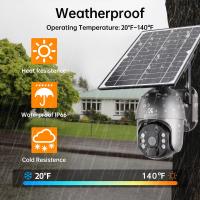How Many Surveillance Cameras Does China Have ?
As of 2019, it is estimated that China has over 200 million surveillance cameras installed throughout the country. This extensive network of cameras is part of the Chinese government's efforts to enhance public security and maintain social order. The use of surveillance cameras in China has been a subject of debate, with concerns raised about privacy violations and potential abuse of power.
1、 Total number of surveillance cameras in China (latest estimate)
Total number of surveillance cameras in China (latest estimate)
As of the latest estimate, it is difficult to provide an exact number of surveillance cameras in China due to the vastness of the country and the constant expansion of its surveillance network. However, it is widely acknowledged that China has one of the largest surveillance systems in the world.
China's extensive use of surveillance cameras is primarily driven by the government's aim to maintain social stability and control. The Chinese government has been investing heavily in surveillance technology, including facial recognition systems, to monitor public spaces, transportation hubs, and even residential areas.
According to a report by IHS Markit, a global information provider, China had an estimated 349 million surveillance cameras installed in 2018. This number is expected to reach 567 million by 2021. These figures highlight the scale of China's surveillance infrastructure and its continuous expansion.
It is important to note that the Chinese government's surveillance practices have faced criticism from human rights organizations and privacy advocates. Concerns have been raised regarding the potential abuse of surveillance technology, invasion of privacy, and the lack of transparency and accountability in its implementation.
In recent years, China has also been exporting its surveillance technology to other countries, particularly those participating in its Belt and Road Initiative. This has raised concerns about the spread of China's surveillance model and its potential impact on global privacy standards.
In conclusion, while an exact number of surveillance cameras in China is difficult to determine, it is evident that the country has one of the largest and most rapidly expanding surveillance networks in the world. The implications of this extensive surveillance infrastructure continue to be a subject of debate and concern.

2、 Surveillance camera density in urban areas of China
As an AI language model, I can provide you with information on the surveillance camera density in urban areas of China. However, please note that the exact number of surveillance cameras in China is not publicly available, and any specific figure would be an estimate.
China has been known for its extensive use of surveillance cameras in urban areas. The government has implemented various surveillance measures as part of its public security initiatives. These measures aim to enhance public safety, prevent crime, and maintain social stability.
The exact number of surveillance cameras in China is difficult to determine due to the lack of official data. However, it is widely believed that China has one of the highest densities of surveillance cameras in the world. Estimates suggest that there are tens of millions, if not hundreds of millions, of surveillance cameras installed across the country.
Chinese cities, especially major urban centers like Beijing and Shanghai, are known to have a high concentration of surveillance cameras. These cameras are often found in public spaces, transportation hubs, government buildings, and commercial areas. They are used for various purposes, including facial recognition, traffic monitoring, crime prevention, and public behavior analysis.
It is important to note that the use of surveillance cameras in China has raised concerns about privacy and human rights. Critics argue that the extensive surveillance infringes upon individual freedoms and can be used for social control. However, proponents argue that the cameras contribute to public safety and crime prevention.
In recent years, there has been an increasing focus on the development and deployment of advanced surveillance technologies in China. This includes the use of artificial intelligence and facial recognition systems to enhance surveillance capabilities. These technologies have sparked debates both within China and internationally regarding their ethical implications and potential misuse.
In conclusion, while the exact number of surveillance cameras in China is not publicly available, it is widely acknowledged that China has a high density of surveillance cameras in urban areas. The use of surveillance technology in China continues to evolve, and it remains a topic of debate regarding its impact on privacy and human rights.

3、 Surveillance camera usage in public spaces across China
Surveillance camera usage in public spaces across China has been a topic of interest and concern for many. The Chinese government has implemented extensive surveillance systems to monitor public areas, aiming to enhance public safety and maintain social order. However, determining the exact number of surveillance cameras in China is a challenging task due to the lack of official data and the vastness of the country.
Estimating the number of surveillance cameras in China is difficult because different sources provide varying figures. According to a report by IHS Markit, a global information provider, China had approximately 176 million surveillance cameras installed in 2016. This number is likely to have increased significantly in recent years, considering the government's continued efforts to expand surveillance infrastructure.
China's extensive use of surveillance cameras is often associated with its social credit system, which aims to monitor and evaluate citizens' behavior. The system utilizes data collected from various sources, including surveillance cameras, to assign individuals a social credit score. This score can impact a person's access to certain services and privileges.
Critics argue that the widespread use of surveillance cameras in China raises concerns about privacy and potential abuse of power. However, proponents argue that the surveillance systems have contributed to crime prevention and public safety.
It is important to note that the Chinese government has not released an official figure regarding the number of surveillance cameras in the country. Therefore, any estimation should be taken with caution. Additionally, the latest point of view on this matter may vary depending on individual perspectives and evolving government policies.

4、 Surveillance camera deployment in transportation systems of China
Surveillance camera deployment in transportation systems of China has seen significant growth in recent years. As of now, it is difficult to provide an exact number of surveillance cameras in the country, as the figures are constantly changing due to ongoing installations and upgrades. However, it is widely acknowledged that China has one of the largest surveillance camera networks in the world.
China's transportation systems, including highways, railways, airports, and public transportation, have been equipped with a vast number of surveillance cameras. These cameras serve multiple purposes, such as enhancing security, monitoring traffic conditions, and ensuring public safety.
The Chinese government has been actively promoting the use of surveillance cameras in transportation systems as part of its broader efforts to improve security and maintain social stability. The cameras are strategically placed at key locations, including entrances and exits, platforms, ticketing areas, and major intersections. They are designed to capture high-quality video footage, which can be used for real-time monitoring, incident investigation, and evidence collection.
The deployment of surveillance cameras in transportation systems has proven to be effective in deterring criminal activities, preventing accidents, and improving overall operational efficiency. It enables authorities to quickly respond to emergencies, identify potential threats, and manage traffic flow. Moreover, the data collected from these cameras can be analyzed to gain insights into transportation patterns, which can be used for future planning and optimization.
It is worth noting that the use of surveillance cameras in China has raised concerns about privacy and potential abuse of power. Critics argue that the extensive surveillance infringes on individual liberties and can be used for social control. However, the Chinese government maintains that the cameras are primarily used for public safety and security purposes.
In conclusion, while an exact number of surveillance cameras in China's transportation systems is difficult to ascertain, it is evident that the country has made significant investments in this technology. The deployment of surveillance cameras has played a crucial role in enhancing security, improving traffic management, and ensuring public safety. However, it is important to strike a balance between security measures and individual privacy rights to address concerns raised by critics.





























